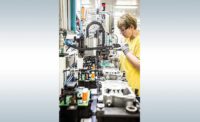The kaizen team goes through a brief training class on the objectives of the project and pertinent lean strategies that they will be using during the project. Over the course of the week, possible new layouts are designed on paper and the best is selected for trial on the plant floor.
The layout is tested and refined over the next few days until most of the bugs are worked out, and procedures for the new cell(s) are developed. The project typically ends with a report-out to management and a demonstration of the new, leaner process.
“Layout kaizenis generally used to implement a single workcell for a particular product or product group,” says Quarterman Lee, president of Strategos Inc. “Participants should include representation from [operations], engineering, scheduling, maintenance and other areas that will be involved.”
“Focus on the elimination of muda (waste) and you will get to the best layout,” notes Sammy Obara, president of Honsha Associates. “Digging deeper, this means there are several elements to take into consideration to know how a layout can be improved. Are machines dedicated or shared? Are cycle times rigid or adjustable? Do you connect processes physically or artificially through kanbans?
“I [once] had a sensei who would demand me to come up with five kaizens every day,” explains Obara, who spent three years studying lean manufacturing principles in Toyota City, Japan, and another 10 years applying it at Toyota plants in Brazil, Venezuela and the United States. “[It was a] tremendous trial and error effort, which my sensei used to call ‘trystorming,’ instead of brainstorming.
“Once you select and implement your best trystorming option, it becomes easier to see possible kaizens,” claims Obara. “The core concept remains the same, no matter if the kaizen is for layout or process or support functions. You always need to follow three steps: address waste, eliminate the root cause and standardize the implementation.”
According to Matt Zayko, an associate at the Lean Transformations Group, layout kaizen is the third step in the kaizen approach. “After observing and standardizing, then comes process kaizen, since it is the lowest cost [way to improve] methods and part presentation. Second is equipment kaizen, such as improving machine movements and cycle initiation. Last is layout kaizen, since it is usually the most expensive.”



